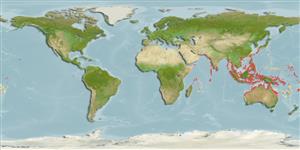Environment: milieu / climate zone / пределы глубины / distribution range
экология
морской; пресноводный; солоноватоводный демерсальный; амфидромный (Ref. 51243); пределы глубины 0 - 5 m (Ref. 90102). Tropical; 20°C - 28°C (Ref. 13371); 35°N - 33°S, 48°E - 171°W
Indo-Pacific: Kuwait to Fiji, north to southern Japan, south to New Caledonia. Reported from Samoa (Ref. 9710), Tonga (Ref. 53797), and the Society Islands (Ref. 2847).
Length at first maturity / Size / Вес / Возраст
половая зрелость: Lm ?, range 14 - ? cm
Max length : 45.0 cm TL самец/пол неопределен; (Ref. 108711); common length : 20.0 cm TL самец/пол неопределен; (Ref. 3489)
колючие лучи спинного плавника (общее число) : 10 - 11; членистые (мягкие) лучи спинного плавника (общее число) : 16 - 18; колючие лучи анального плавника: 4; членистые (мягкие) лучи анального плавника: 13 - 15. Ground colour greenish. Juveniles with a few large roundish blotches, about size of eye, or with about 5 or 6 broad, dark, vertical bars. In large adults, spots may be faint and restricted to dorsal part of flanks. Body quadrangular, strongly compressed. Dorsal head profile steep. Eye moderately large, its diameter somewhat smaller than snout length. Snout rounded. Mouth small, horizontal, not protractile. Teeth villiform, in several rows on jaws (ref 43044).
Body shape (shape guide): short and / or deep.
Inhabit harbors, natural embayments, brackish estuaries and the lower reaches of freshwater streams, frequently occurring among mangroves. Feed on worms, crustaceans, insects and plant matter (Ref. 7020, 44894, 48637). The dorsal, anal and pelvic spines are believed by Philippine fishers to be venomous and capable of inflicting wounds (Ref. 6565). Used in Chinese medicine (Ref. 12166). In Hong Kong live fish markets (Ref. 27253). Marketed as fresh (Ref. 12693).
Multiple spawner (Ref. 102820).
Allen, G.R., 1984. Scatophagidae. In W. Fischer and G. Bianchi (eds.) FAO species identification sheets for fishery purposes. Western Indian Ocean (Fishing Area 51). volume 4. [var. pag.]. FAO, Rome. (Ref. 3489)
Статус Красного Списка МСОП (Ref. 130435: Version 2025-1)
Использование человеком
рыболовство: не имеет хозяйственного значения; аквакультура (рыбоводство): коммерческий; аквариум: коммерческий
дополнительная информация
инструменты
Специальные отчеты
Скачать в формате XML
ресурсы в Интернет
Estimates based on models
Preferred temperature (ссылка
123201): 25.4 - 29.3, mean 28.6 °C (based on 2701 cells).
Phylogenetic diversity index (ссылка
82804): PD
50 = 0.8125 [Uniqueness, from 0.5 = low to 2.0 = high].
Bayesian length-weight: a=0.03236 (0.02357 - 0.04442), b=2.92 (2.83 - 3.01), in cm total length, based on LWR estimates for this species (Ref.
93245).
Trophic level (ссылка
69278): 3.0 ±0.35 se; based on food items.
Generation time: 0.9 ( na - na) years. Estimated as median ln(3)/K based on 1
growth studies.
устойчивость к внешним воздействиям (ссылка
120179): высокий, минимальное время удвоения популяции до 15 месяцев (K=0.97; tm=1; Fec=486,500).
Fishing Vulnerability (Ref.
59153): Low vulnerability (20 of 100).
🛈
Nutrients (Ref.
124155): Calcium = 80.7 [40.4, 127.3] mg/100g; Iron = 0.8 [0.5, 1.4] mg/100g; Protein = 19.2 [18.0, 20.3] %; Omega3 = 0.0919 [, ] g/100g; Selenium = 28.9 [14.3, 62.6] μg/100g; VitaminA = 22.8 [6.1, 87.4] μg/100g; Zinc = 1.49 [0.96, 2.24] mg/100g (wet weight); based on
nutrient studies.
